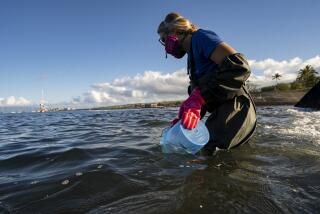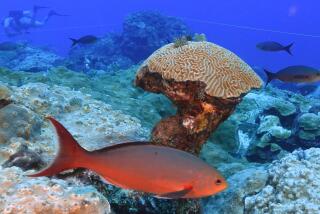Sri Lankan Reefs in a Struggle for Survival
- Share via
UNAWATUNA, Sri Lanka — Just a thousand feet offshore from this beachside town lies what should be a wondrous underwater world of color and activity, a realm of angelfish, gobies and other aquatic beauties darting among sun-dappled reefs.
But instead of a diver’s delight, the area is an ecologist’s lament. The tsunami that swept through the Indian Ocean 1 1/2 years ago sent debris and rubble crashing into the coral reefs surrounding this island nation, damaging delicate natural formations that already were struggling to survive.
Gloomy walls of brown now thread the water where blue and pinkish polyps flowered. Once-plentiful fish easily spotted by swimmers are in dwindling supply.
“We go diving, but there’s not so much color and not so much coral,” said Shelton Wijesena, who manages a scuba and snorkeling center here on Sri Lanka’s southern coast.
Experts say recovery from the destruction wrought by the tsunami could take as long as 20 years in the hardest-hit reefs -- or even longer if heedless human activities, such as harmful fishing practices, continue. In areas spared serious damage, the coral could regenerate in as little as five to 10 years, but there, too, human interference could prolong the process.
The reefs, formed by colonies of coral polyps, serve as habitats for creatures such as fish and mollusks. Coral also plays an important role in regulating carbon dioxide levels in the oceans and provides coastlines a measure of protection from strong currents and waves.
The 2004 Indian Ocean tsunami, the most devastating ever recorded, damaged reefs from Asia to East Africa, from Indonesia to Kenya. Churning water tossed giant coral boulders like pebbles, hurled heavy debris onto reefs and smothered some outcroppings under sand and backwashed soil.
In Sri Lanka, off India’s southern tip, the disaster compounded already-catastrophic coral losses suffered in 1998, when a rise in ocean temperatures from an El Nino weather pattern triggered massive “coral bleaching.” In that phenomenon, coral tissues, ultra-sensitive to heat, expel the algae cells that nourish and give them color, leaving them starved and bone-white.
Scientists estimate that the live coral cover around Unawatuna plummeted from 47% of the overall coral bed in 1997 to less than 1% a year later. But the figure had inched up to 16% by the end of 2004.
Then the tsunami wiped away some of those fragile gains, with chunks of long-expired coral scattered around the seabed proving to be their living counterparts’ worst enemy.
“When the tsunami came, all the dead coral, mostly rubble, was shifted. All this rubble has got piled up in certain areas,” said Arjan Rajasuriya, a government scientist who is Sri Lanka’s leading authority on coral reefs.
The battering uprooted, broke apart and abraded many sections of living coral. Some patches were completely buried under rubble.
And when the tsunami waves receded from land, they carried parts of boats, lampposts, tables, chairs, carpets, plastic bags and other debris out to sea, creating an enormous litter heap.
Conditions for recovery from the 1998 bleaching “were poor to begin with,” Rajasuriya said. “The tsunami worsened what was already there.... I don’t know how long it will take to recover.”
The areas affected most by the tsunami were in the south and east, regions famous for their pristine beaches, crystal-clear water and abundant marine life along the reefs.
Here in the south, the formations have been particularly slow to bloom again. Strong waves have prevented coral larvae from settling and fusing together as quickly as they would in more placid water, such as in the east, where signs of regrowth have been more encouraging.
Adding to the troubles is human depredation.
Residents in some areas mine coral for use in manufacturing cement, a product in high demand as people rebuild homes destroyed by the tsunami.
Also, the worldwide trade in aquarium fish -- blue and yellow angelfish, striped butterfly fish, colorful damselfish -- has not only depleted those stocks but caused harm to the reefs, because trappers break or gouge out lumps of coral to get at creatures sheltering in the nooks and crannies.
Conservationists are especially alarmed by the rise in “blast fishing,” illegal commercial fishing with dynamite. The Sri Lankan government has increased penalties for such activity, but a report released this year by the international Global Coral Reef Monitoring Network says the regulations are not enforced.
When Wijesena, the snorkeling center manager, is out on dives, he sometimes sees geysers shoot up in the distance, a sure sign of blast fishing. Occasionally, he and other divers can hear the closer explosions underwater.
The few fishers who did get hauled into court for using dynamite are fined 5,000 Sri Lankan rupees -- about $50.
“That’s nothing,” said Wijesena, who wants officials to declare the Unawatuna area a marine sanctuary, then back it up with strong enforcement and stiff penalties.
Such a move, however, would require money and political will from a government more concerned with human rehabilitation after the tsunami, economic growth and now the possible resumption of the civil war with ethnic Tamil rebels, which has killed more than 64,000 people over 23 years.
Rajasuriya is not optimistic. Lack of coordination between the ministries responsible for coastal management, wildlife conservation and fisheries hampers efforts to help Sri Lanka’s reefs bounce back from human and natural destruction. He and his fellow researchers have made recommendations that sit idle on shelves.
“A lot of resources are required for enforcement,” Rajasuriya said. “There is little management here, hardly any. That doesn’t sound very good, but that’s the truth.”
More to Read
Sign up for Essential California
The most important California stories and recommendations in your inbox every morning.
You may occasionally receive promotional content from the Los Angeles Times.














